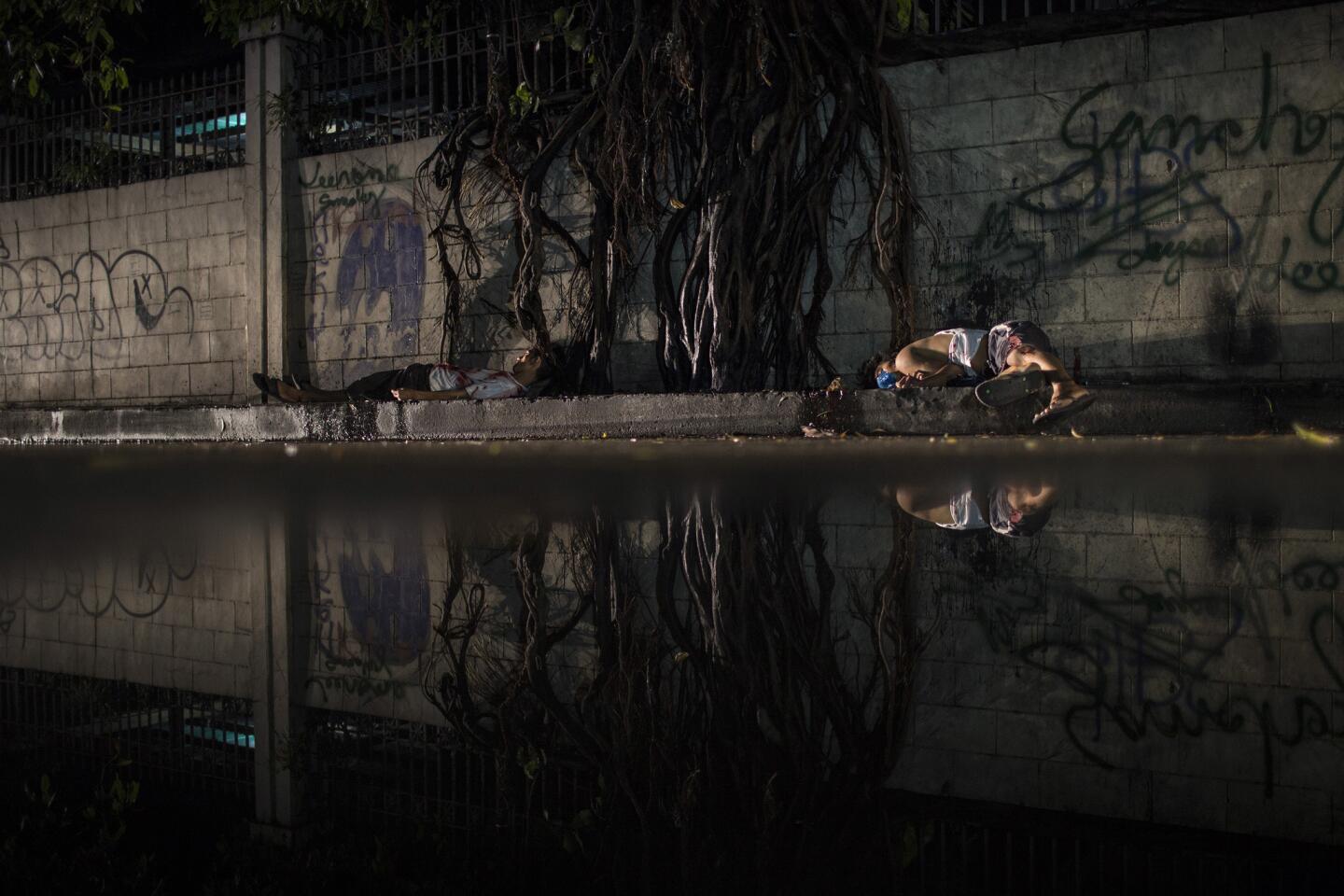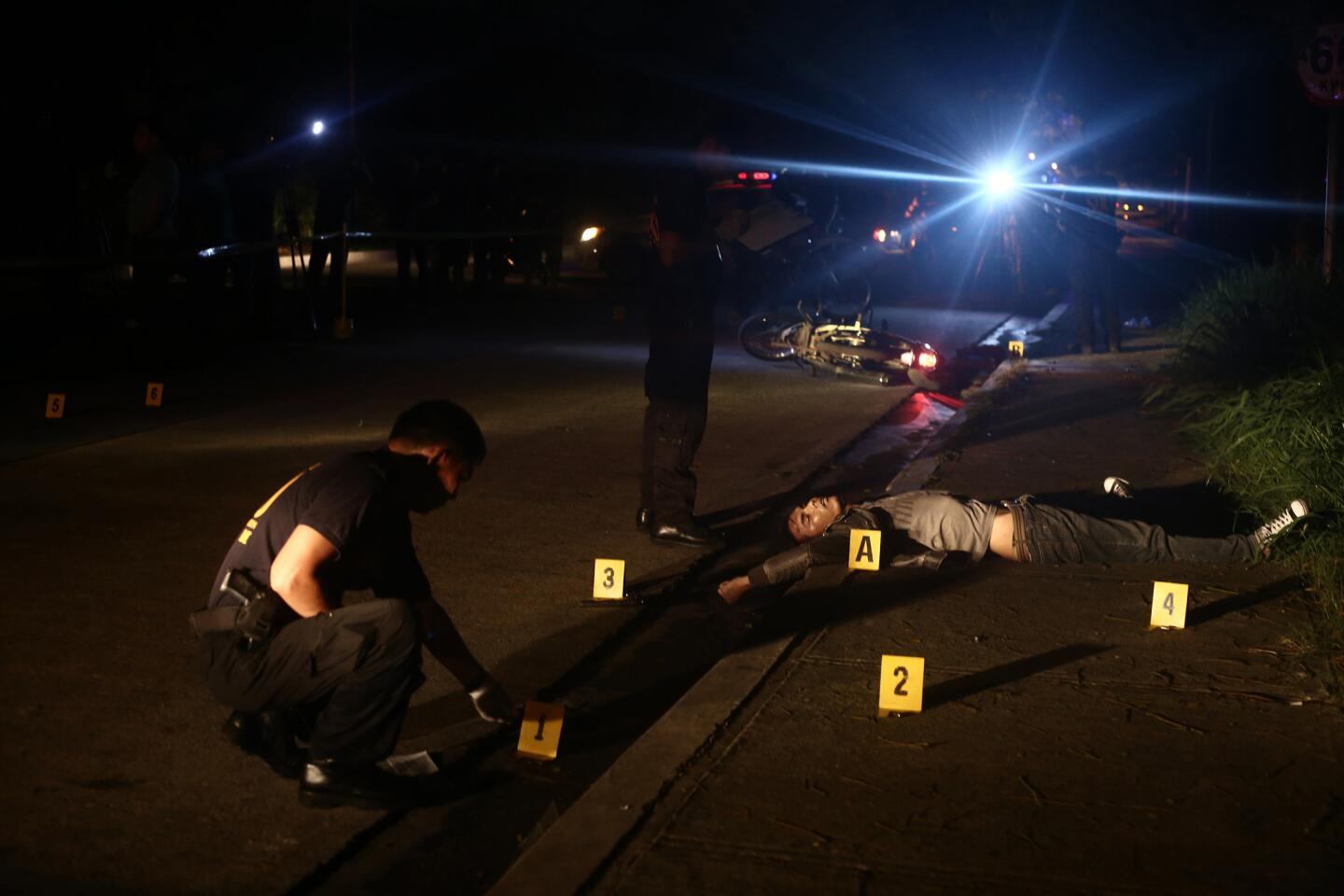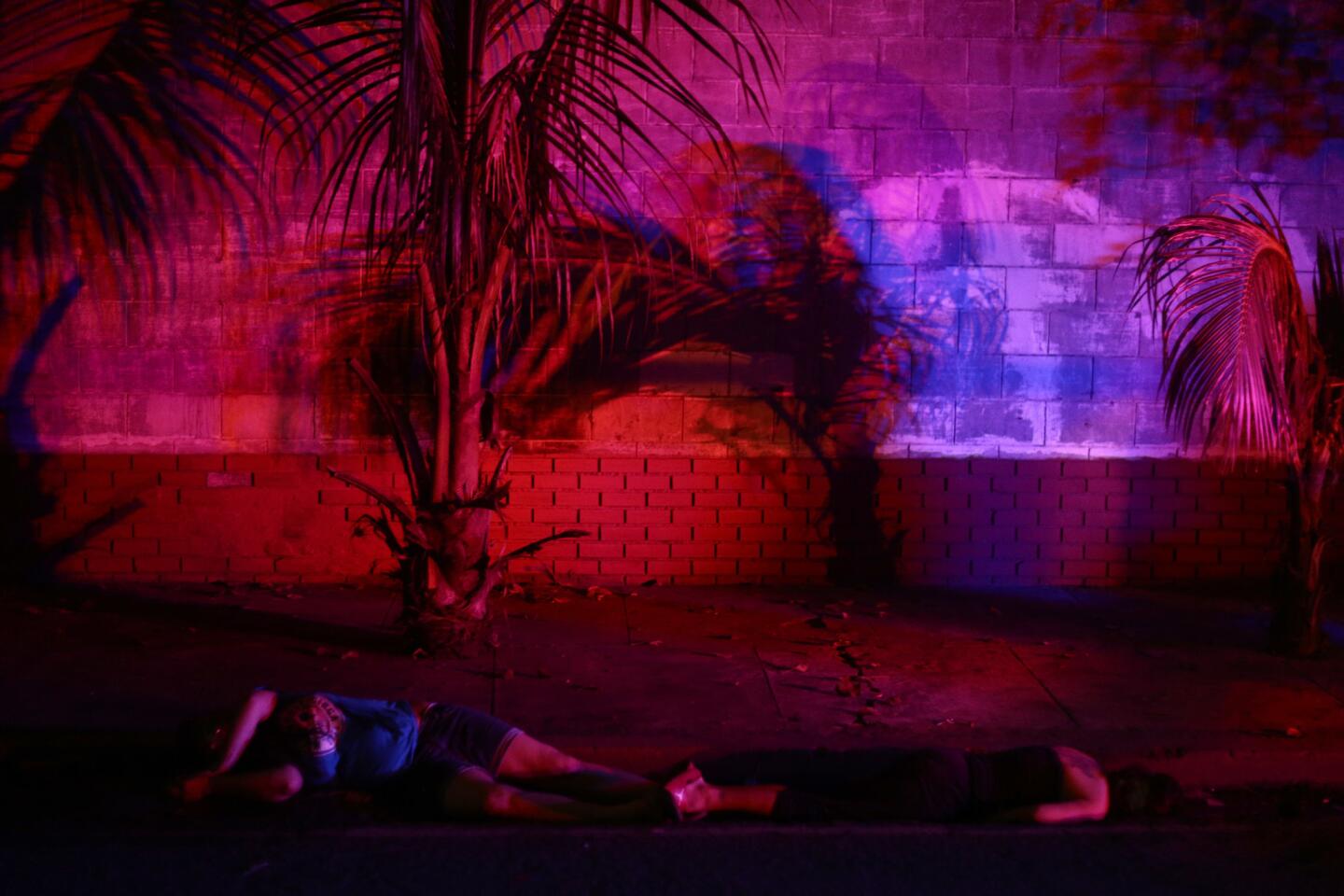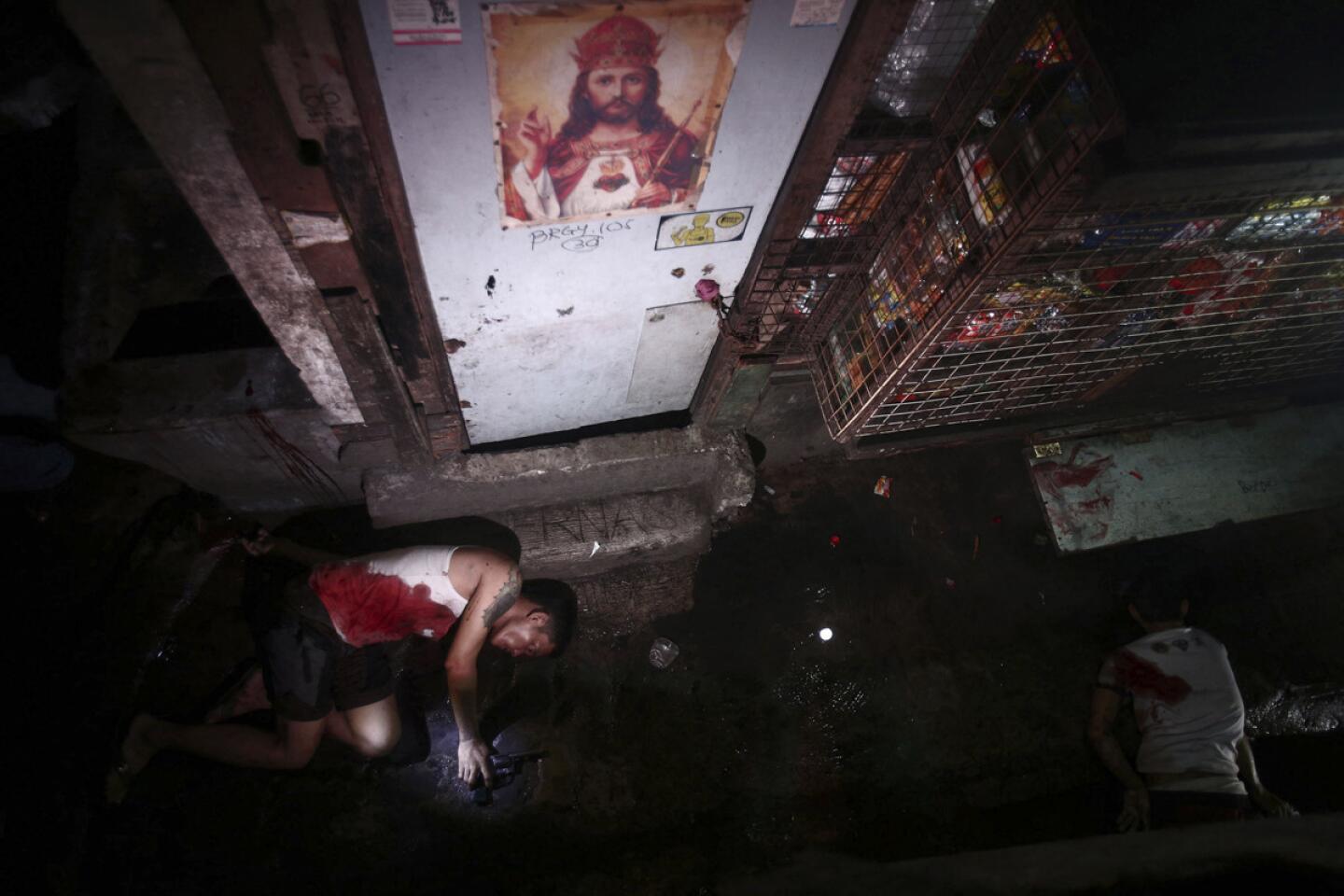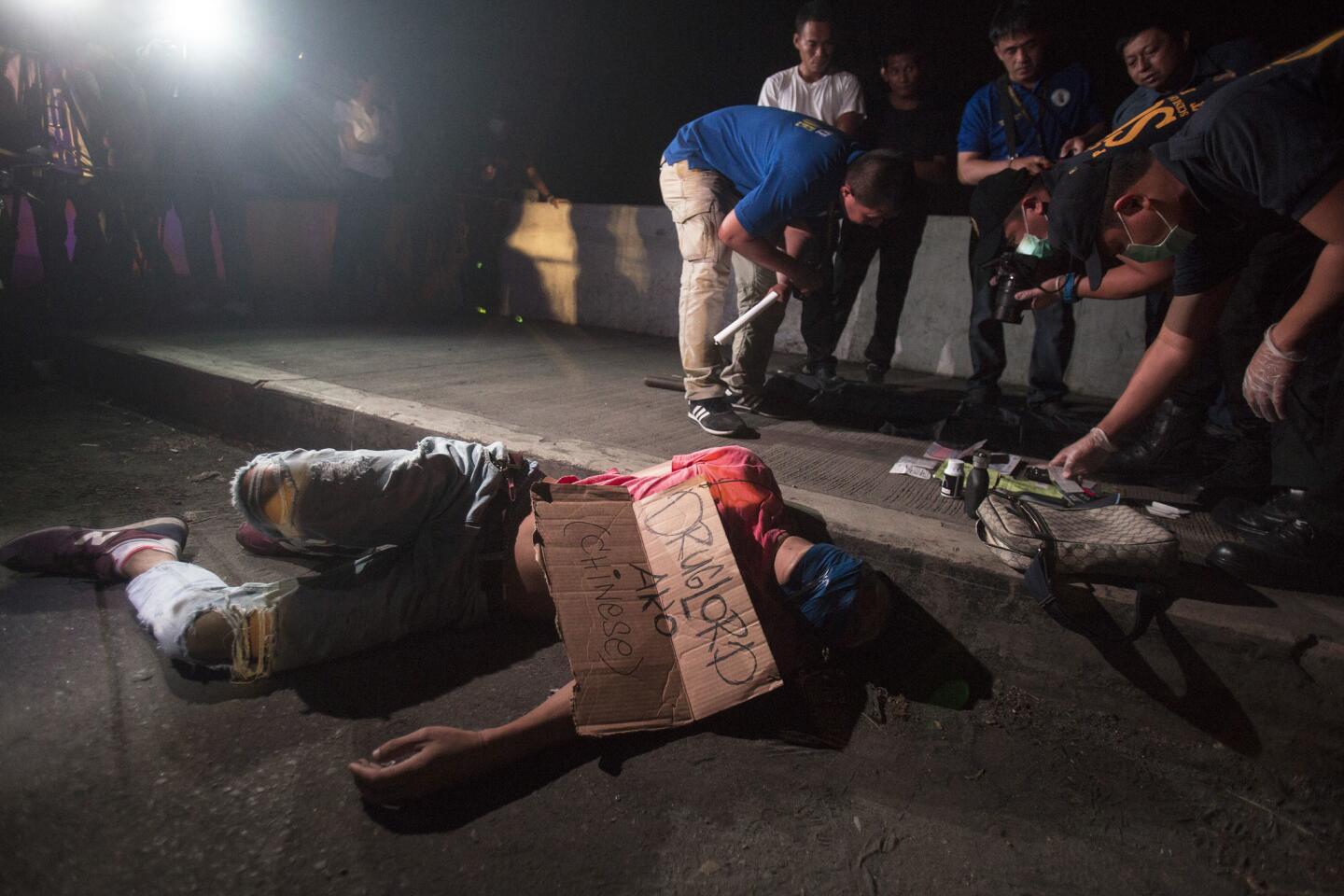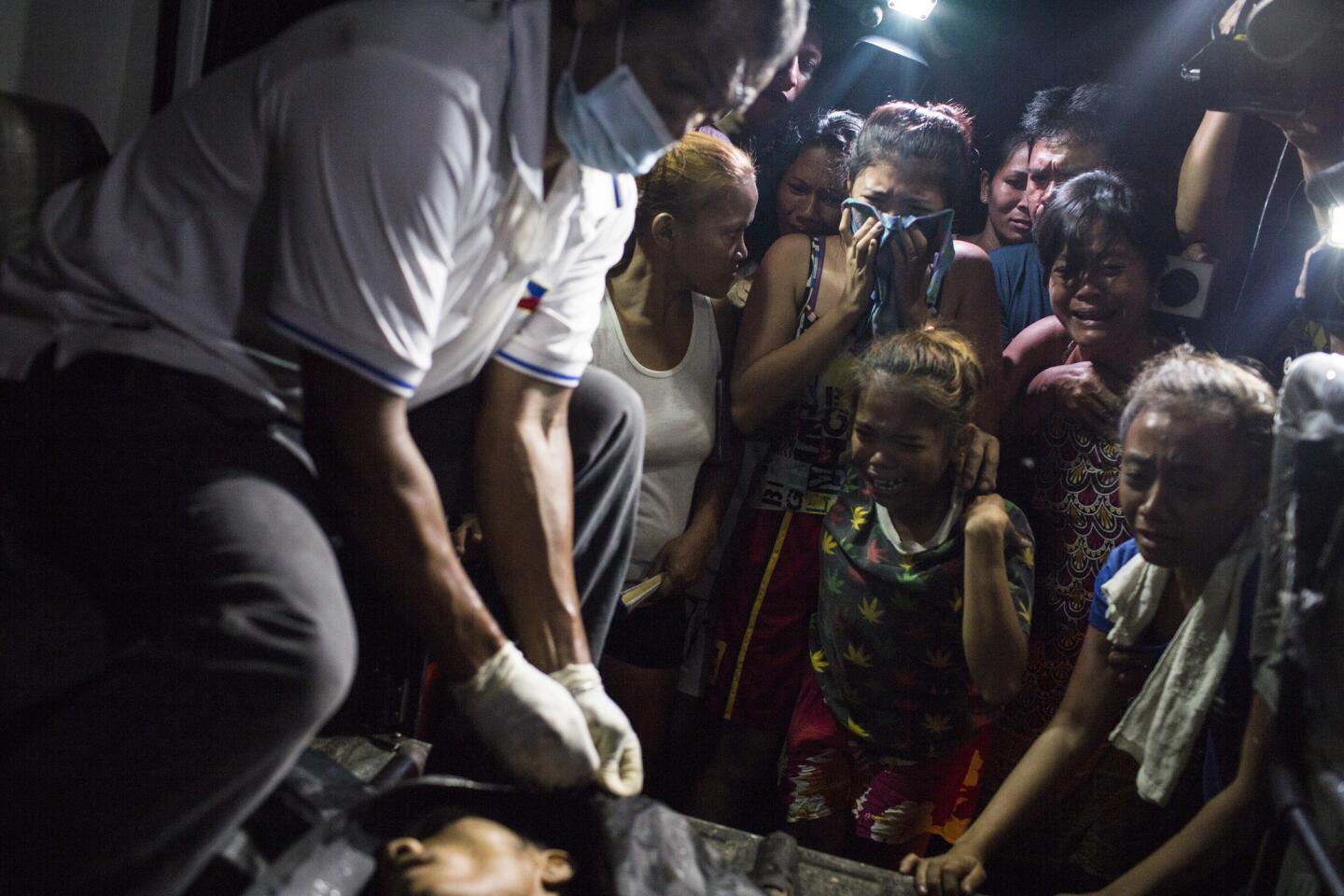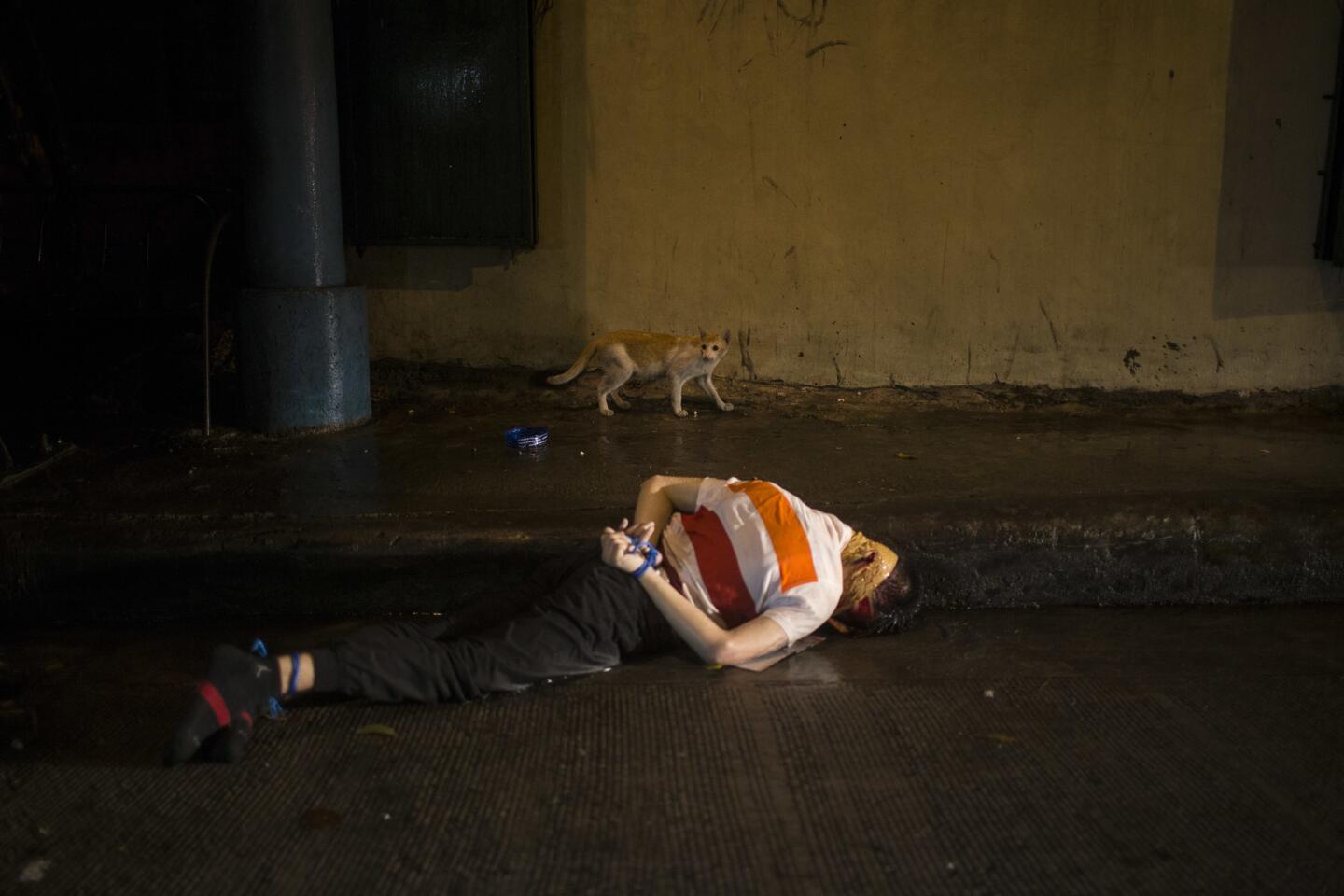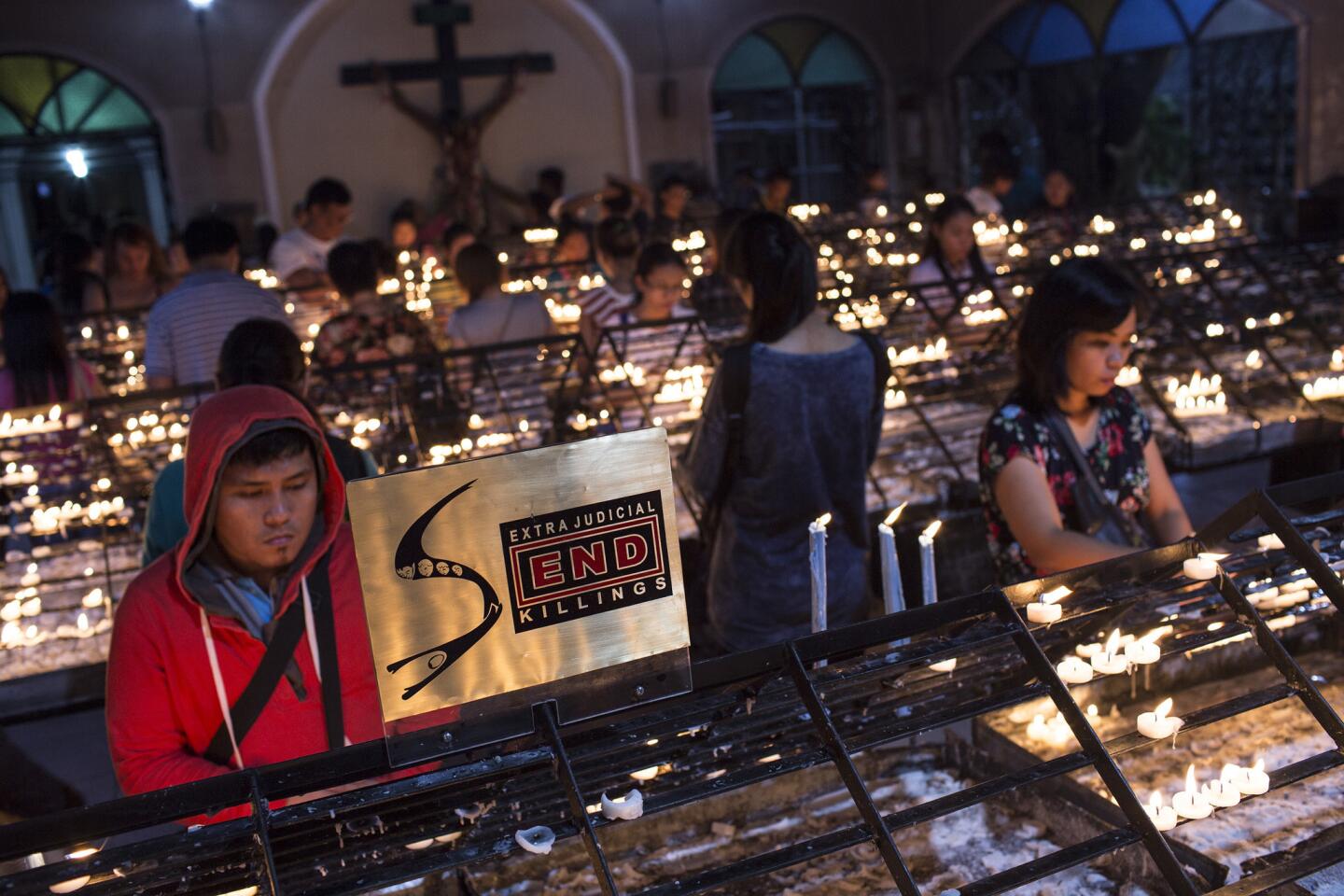Meet the Nightcrawlers of Manila: A night on the front lines of the Philippines’ war on drugs
- Share via
Reporting from Manila — The radio crackled.
Linus Guardian Escandor II knew what was coming. The station, AM 594 kHz, would report a summary execution. He would squeeze into a pickup truck with four other photojournalists, speed through Manila to some rain-slicked slum or dark alley and arrive while the bodies still lay in the streets.
Their hands would likely be tied, their faces wrapped in tape, blood flowing from bullet wounds in their heads and chests.
For more than a month, the scene has played out every night — often twice a night, sometimes more. But on this Thursday morning at 2 a.m., it hadn’t yet — so Escandor, a 37-year-old freelance photographer, sat in the press room at Manila’s police headquarters with about a dozen other photojournalists, the TV on mute, just listening to the radio crackle.
“In the morning, if you shoot dead people, it’s gory, but at night it’s almost beautiful,” he said, clicking through photos on his laptop. “You can hide the blood, because of the shadows. It’s psychedelic, the colors.”
If you shoot dead people, it’s gory, but at night it’s almost beautiful. You can hide the blood, because of the shadows. It’s psychedelic, the colors.
When Escandor began working the graveyard shift in 2014, he mainly covered fires and car accidents. Then, this June, Rodrigo Duterte came to power as president of the Philippines. Duterte, a tough-talking, 71-year-old former mayor of the southern city of Davao, had campaigned on promises to eradicate the country’s drug problem within six months.
He vowed to let nothing stand in his way — not his opposition, not human rights, not due process.
“Please feel free to call us, the police, or do it yourself if you have the gun — you have my support,” he said on June 6, in a nationally televised address. “Shoot [the drug dealer] and I’ll give you a medal.”
Since Duterte was inaugurated on June 30, the bodies have been piling up. About 1,900 people have been killed, according to local media, the vast majority of them poor. Among them, more than half were executed by vigilantes, often gunmen on motorcycles. The rest were killed by police.
See the most-read stories in World News this hour »
And thus Escandor, a bald, bright-eyed man with a muted intensity, found himself on the execution beat. This was a historic moment, he thought. Illegal drugs, particularly the methamphetamine “shabu,” have been endemic in the Philippines for years, and Duterte’s efforts to stamp them out have proved enormously popular — he enjoys a 91% approval rating, the polling organization Pulse found in July. Yet critics have warned of a breakdown in social order; without due process, they say, the country could sink into a mire of unaccountable killings.
So Escandor and his colleagues have spent every night chasing “The Shot” — something powerful enough to shine a light on the crackdown’s human cost. Something that could change the conversation.
Suddenly, somebody turned up the radio, until voices roared out of a static haze. “There’s one,” Escandor said — two bodies on a nearby highway. The journalists gathered their equipment, ran out into the rain, jumped into their pickup trucks and sped into the night.
Shoot [the drug dealer] and I’ll give you a medal.
— Rodrigo Duterte
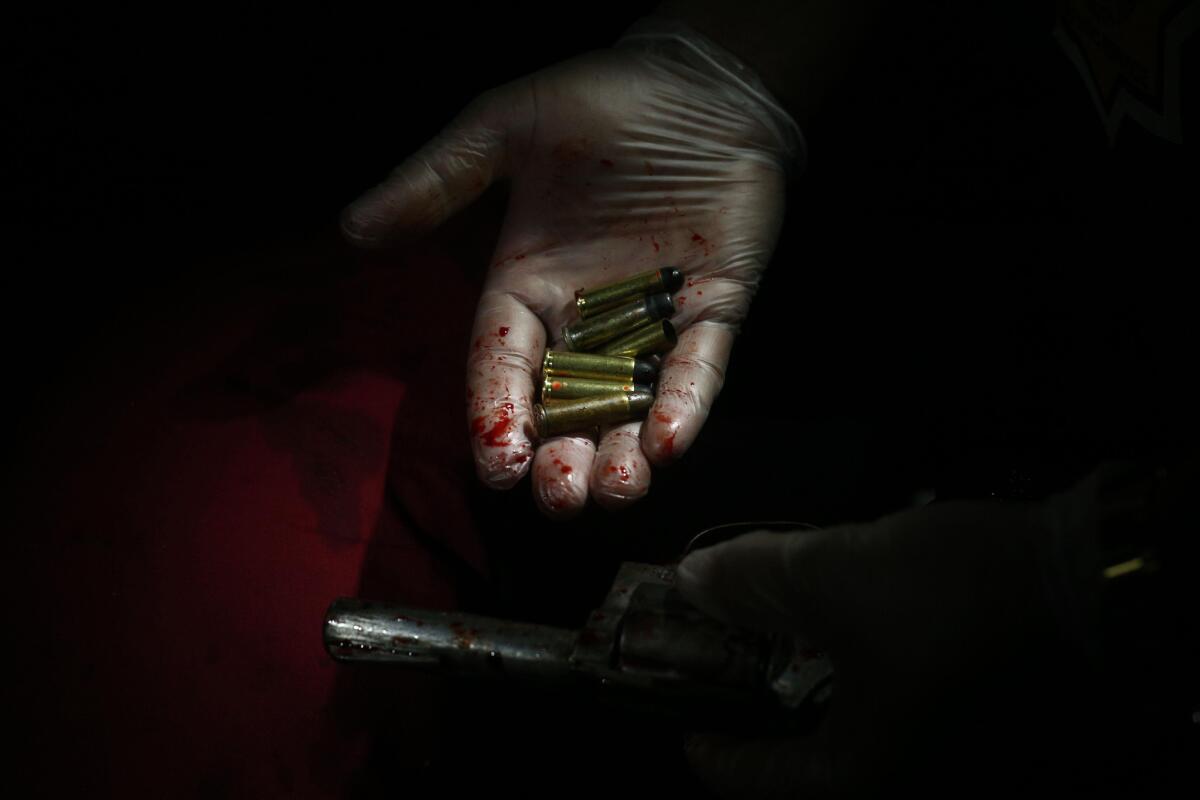
The evening had begun at 9:20 p.m., with a group dinner of tapsilog — a Filipino dish of beef jerky, egg, and rice — and a failed attempt at photographing a recently slain local official, who lay in an autopsy room surrounded by family, police keeping watch outside.
Just after midnight, they decided to visit a wake. A Manila Bulletin newspaper employee drove them in a company pickup truck. They passed stray dogs, drunk teenagers and emaciated men sleeping beneath highway on-ramps, and stopped near an alley between two crumbling low-rises, where white lights shone from a trio of canopy tents.
Beneath one, Ricardo de Lemon, 36, lay in a white open casket, his face thick with funeral makeup. A few feet away, his wife, Gima Ros de Lemon, 29, sat receiving guests.
“We have seven children,” she said. Behind her, a throng of men huddled over a coin-tossing game, betting stacks of cash.
Ricardo drove a jeepney, she said — a clunky stretched jeep that serves as the country’s most popular form of public transport. On Aug. 6, nearing the end of a long shift, she sat with him in the vehicle’s front seat; behind them, a lone passenger was obscured by shadows. He wore a black cap and a black jacket with a white shirt underneath.
“That passenger had a gun with a silencer,” she recalled.
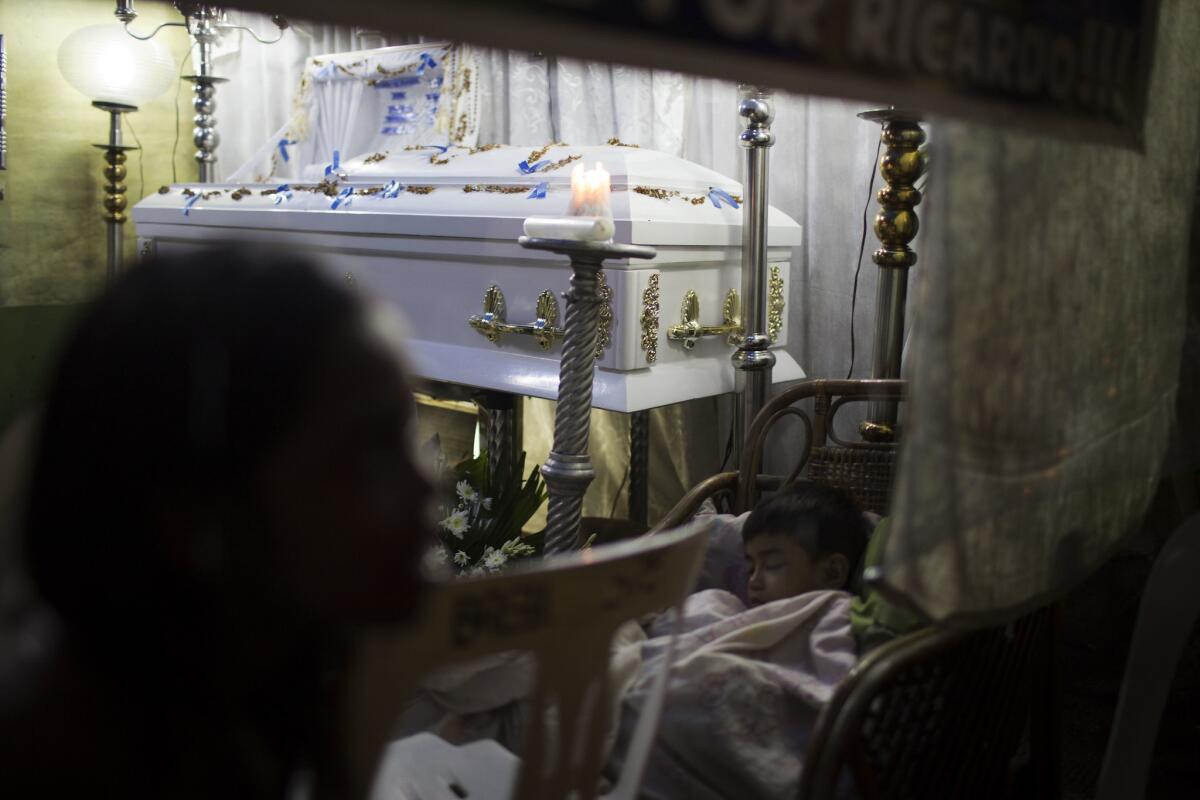
The man fired and missed. Then he fired a few more rounds, hitting Ricardo twice. “I saw the man pointing the gun at me, and I closed my eyes,” she said. “I said to myself, ‘Lord, please take care of my children.’”
Then, a shock — her husband mustered some strength and threw her out of the vehicle. The man fired again; the bullet hit Ricardo and Ricardo died.
De Lemon produced a folder stuffed with photographs, court documents and medical records. Ricardo never did drugs, she said. In early 2015, though, he spent 19 days in prison on robbery charges. There, police beat him, and later, freed on bail, he sued them for abuse. A court agreed to hear his case in September.
“That case was likely the reason for the assassination,” she said.
De Lemon laid down her stack of papers and picked up her infant daughter. The men continued gambling, silent except for the clinking of coins.
On July 23, Escandor and his colleagues were covering a summary execution when they got wind of a nearby incident, so they drove to the scene, and what they found there shocked them.
A young woman sat on the pavement, cradling the body of her dead husband, bathed in the light of television cameras. The words “drug pusher” adorned a cardboard sign at their feet. “Tell my papa to come here,” she wailed, according to Escandor. “Help us.”
“We were all silent, stunned,” Escandor recalled. “Because it was the first time we felt that kind of emotion.”
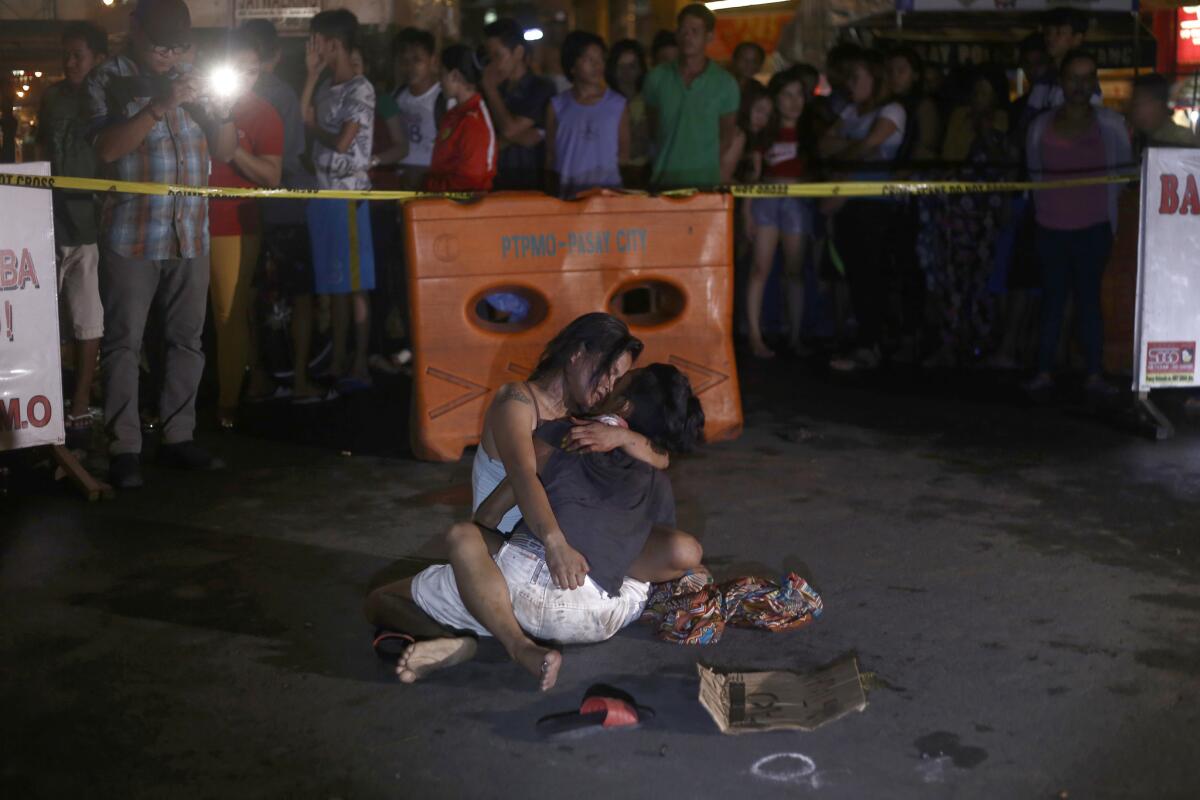
This, he thought, might be The Shot. One of those rare images so heartbreaking, so raw, that it could turn the tide of public opinion — like the “Napalm Girl” photo in 1972, which came to represent the horrors of the Vietnam War, or the 1993 image of a vulture stalking a starving toddler in Sudan, which directed a flood of international attention toward the war-torn country.
They dubbed it “The Pieta,” after a 1499 sculpture by Michelangelo, depicting the Virgin Mary cradling her son Jesus’ dead body. The following day, the Philippine Daily Inquirer, the Philippines’ widely read broadsheet newspaper, ran the photo — taken by Raffy Lerma, a staff photographer — on its front page. Beneath it read the headline: “Church: Thou Shalt Not Kill.”
But the outrage never came. On July 25, Duterte, in his first State of the Nation address, accused the newspaper of “doing dramatics,” and his supporters rallied on social media. They called the photograph “yellow journalism” and suggested that the journalists were bankrolled by the president’s enemies — perhaps even the drug lords themselves.
“This was unprecedented,” Vincent Go, a local photographer for the Hong Kong-based Union of Catholic Asian News, said during a lull in the evening. The other photojournalists nodded.
“It’s like a gang thing — they’re trying to discredit the media,” said Lerma, the Philippine Inquirer photographer.
“I don’t feel safe,” Ezra Acayan, 22, a freelancer for an international news agency, said later, in an unguarded moment. “Anytime motorcyclists pull up alongside my car, wearing full face helmets, I always think they’re going to assassinate me or something.”
He went quiet for a moment, then laughed. “I always try to remember if somebody wants me dead.”
This time, they drove fast. They drove past shuttered storefronts, a trash-strewn canal, a faded “Duterte for President” campaign poster hanging from a telephone pole. About 10 minutes later, the car slowed.
“See that traffic?” Escandor said, peering out at a line of trucks. “That’s because of the bodies.”
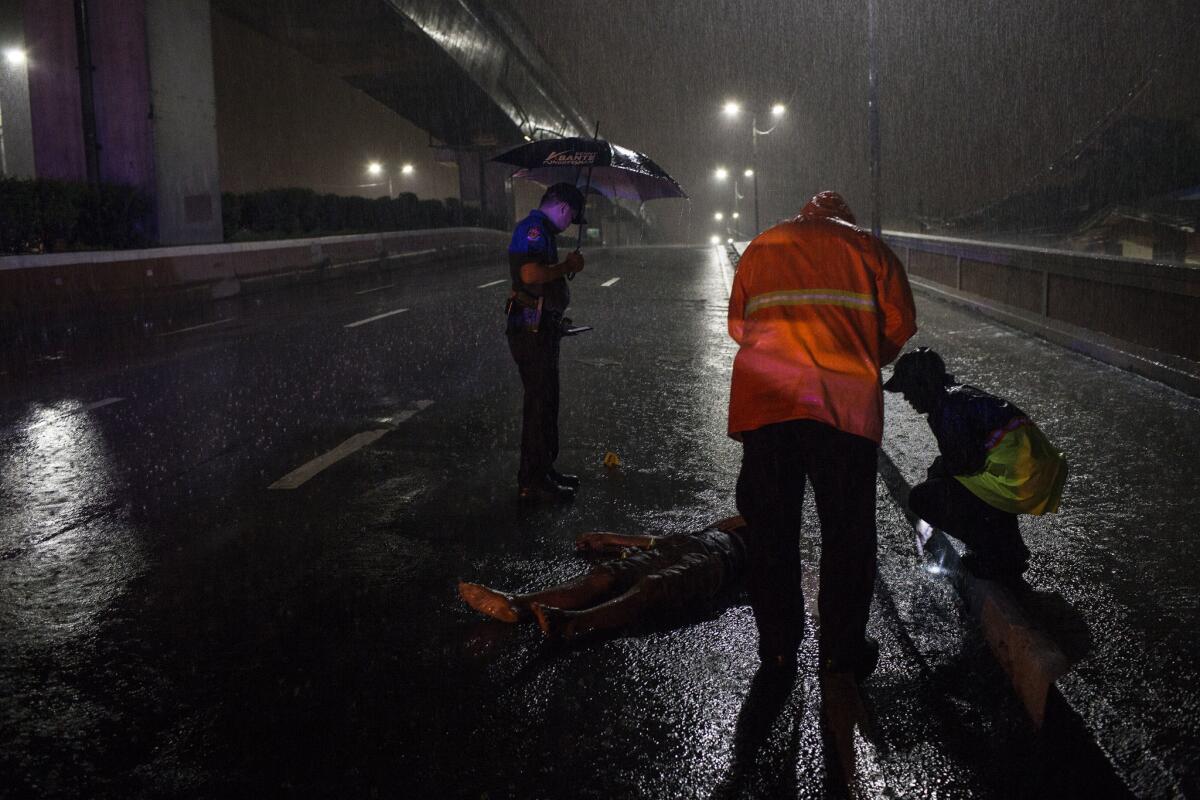
The photographers stepped out into a torrential downpour and weaved through the trucks to a roadblock, eerie in the glare of red and blue police lights.
They were tough to make out at first: a young man, perhaps a teenager, curled up lifeless by the concrete divider; and about 50 feet away, another person — an older man with a wispy mustache — sprawled on the pavement barefoot, his head matted in blood. Escandor raised his camera.
Duterte’s war on drugs claimed 21 victims that day, Aug. 11, according to the Philippine Inquirer’s “Kill List,” an online resource on the campaign’s death toll. Among them, 14 were killed by police and at least six by “unknown hit men.”
The Inquirer listed the men on the highway as “unidentified suspect #203 and #204 … alleged robbers … killed in police shootout.”
Before long, the police moved the bodies onto stretchers, and the journalists continued to snap photos as their blood washed away with the rain.
Follow me on Twitter @JRKaiman
ALSO
Destruction from Italy quake a grave warning for California’s old brick buildings
93,000 people voluntarily left Japan for North Korea after World War II. Or did they?
From Vietnam to Los Angeles: Photographer who captured iconic image on one road sees end of another
More to Read
Sign up for Essential California
The most important California stories and recommendations in your inbox every morning.
You may occasionally receive promotional content from the Los Angeles Times.

